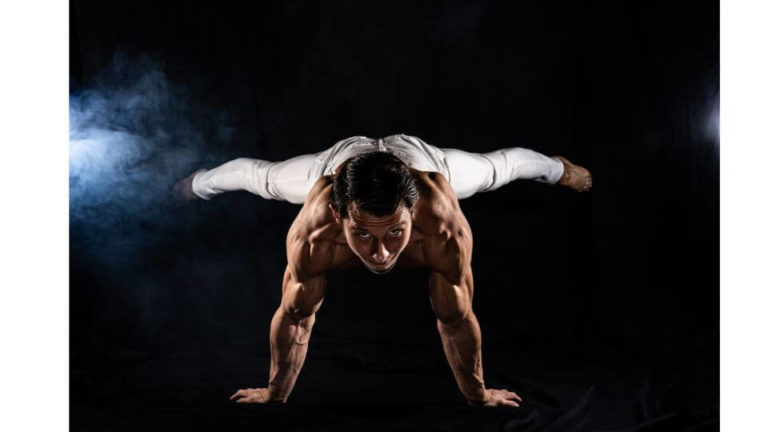10 Reasons Why Calisthenics is Better Than Weights
To be clear there is no bad way to exercise as long as you do the moves correctly and your training plan is in check. Going to the gym is a great way to stay fit so is bodyweight fitness. In fact, the two can perfectly complement each other.

Some of the benefits of calisthenics compared to weight training include that it improves overall functional fitness, flexibility, balance and endurance while it can be adjusted to fit every fitness level and can be performed anywhere with minimal equipment. If you are new make sure to check our article about how to start calisthenics and how to build a calisthenics workout.
1. Calisthenics can be done anywhere without gym membership or equipment.
All the basic exercises can be performed with no equipment at home. Push up, sit up, squats, lunges, handstands and the list goes on. This is especially true for beginners who want to get started with calisthenics. With pull-ups you will encounter some challenges so we recommend installing a horizontal bar or drill a hanger for gymnastics rings somewhere in your home – this way you make your life easier and expand the possibilities for your home workouts immensely. While we are at the minimalist equipment – why don’t you add some resistance bands to your inventory? By doing so you will make your warmups more versatile and further expand your workout routine.
2. Calisthenics is ideal for a full-body workout, while weight training is better at isolating specific muscles.
By using gym machines for example people with injuries can target the development of specific muscle groups without engaging the whole body. Calisthenics on the other hand is based on compound, multi-joint movements that engage different muscle groups at the same time which is ideal for developing overall fitness and functional strength.
3. Calisthenics is cheaper than weight training.
You can do a home workout or hit the calisthenics park close to your house. Whatever you choose you immediately save money on a gym membership – which can cost you a lot of money per year if you add up the monthly fees. Not to mention the value of your time which can be hundreds of hours per year for the gym commute only.
By adding some basic equipment like a pull up bar or a pair of gymnastics rings you basically transformed your home into a fully functional gym for less than $100.
If you prefer to train in the fresh air, chances are there is a calisthenics park near you with some pull up bars and dip stations.
4. Calisthenics can improve overall functional fitness and movement patterns.
You can improve your functional fitness by training the body to perform movements that are similar to those used in everyday life.
As the essence of calisthenics is compound exercises such as squats, lunges, push-ups, and pull-ups, which involve multiple joints and muscle groups. These exercises mimic the movement patterns used in everyday life, such as standing up, sitting down, pushing, and pulling. This type of training can help to improve functional fitness by making these movements easier and more efficient.
By performing bodyweight exercises you will also increase your body awareness as they require you to engage your entire body and use it as primary resistance, which can help to improve body awareness. This is important for overall functional fitness because it allows you to move more efficiently and with better control, which can reduce the risk of injury.
A strong core is essential for overall functional fitness, as it helps to stabilize the spine and improve posture. Exercises such as planks, bridges, and leg raises can help to improve core strength and eventually improve your posture.
5. Calisthenics can improve flexibility and balance.
Calisthenics exercises such as single-leg squats, single-leg deadlifts, and balance exercises can help to improve balance. This is important for overall functional fitness because it allows you to move more efficiently and with better control, which can reduce the risk of injury.
Calisthenics exercises can also improve flexibility which is essential for overall functional fitness, as it allows you to move through a greater range of motion, which can improve movement patterns and reduce the risk of injury.
6. Calisthenics can increase cardiovascular fitness.
Calisthenics exercises can increase cardiovascular fitness by elevating the heart rate and increasing blood flow throughout the body. Some calisthenics exercises, such as burpees, jumping jacks, and running in place, are more cardiovascular in nature and will have a greater impact on cardiovascular fitness.
High-intensity interval training (HIIT) is a form of calisthenics that can be particularly effective for increasing cardiovascular fitness. HIIT involves alternating periods of high-intensity exercise with periods of rest or low-intensity exercise. This type of training can help to improve cardiovascular fitness by increasing the body’s ability to deliver oxygen to the muscles and by improving the efficiency of the cardiovascular system.
Additionally, calisthenics exercises such as push-ups, squats and lunges, will provide a cardiovascular workout by performing them in a circuit format. This means that you perform one exercise after another with little to no rest in between. This type of workout will keep your heart rate elevated and will work the cardiovascular system.
It’s important to note that cardiovascular fitness and overall fitness are related but different. A balanced workout plan should include both cardiovascular and strength training exercises to improve overall health and fitness.
7. Calisthenics can help to reduce the risk of injury.
Calisthenics can help to reduce the risk of injury by strengthening the muscles and improving overall flexibility and balance.
Bodyweight exercises can also help to build a strong core, which will improve the stability of the spine and prevent back injuries.
Additionally, calisthenics exercises can help to reduce the risk of overuse injuries and complement other sporting activities as part of a balanced training plan. It is also important to start slowly and progress gradually, and to always use proper form to reduce the risk of injury.
8. Calisthenics can be better for burning fat.
Calisthenics and weight training are both effective for burning fat, but they may have slightly different mechanisms for doing so. Calisthenics exercises are typically high-intensity, compound movements that engage multiple muscle groups at once and this type of training can increase the amount of calories burned during and after the workout, known as the afterburn effect. This can help to increase the amount of fat burned over time.
Additionally, because calisthenics exercises use your own body weight as resistance, compound movements may be more effective at increasing overall muscle mass, which in turn can help to boost metabolism and burn more calories at rest.
It’s also important to note that both types of exercises have their own benefits and it’s not the worst idea to include both weight training and calisthenics in your training plan.
9. Calisthenics can be easily modified for different fitness levels.
Calisthenics exercises can be modified for different fitness levels by adjusting the intensity, volume, and complexity of the exercises. Some ways to do this include:
- Regressing exercises: For beginners or those with lower fitness levels, exercises can be made easier by using a modified version of the exercise, such as a knee push-up instead of a full push-up or a wall-assisted pull-up.
- Progression: For advanced individuals, exercises can be made harder by adding weight, using a more challenging variation of the exercise, or by increasing the number of reps or sets.
- Volume: The number of sets and reps can also be adjusted to match the individual’s fitness level. Beginners may start with one or two sets of 8-12 reps, while more advanced individuals may perform three or more sets of 12-15 reps or more.
- Tempo: The speed at which the exercise is performed can also be modified. A slower tempo may be better for beginners to focus on form, while a faster tempo may be more challenging for advanced individuals.
- Rest time: The amount of rest time between sets can also be adjusted. Beginners may need more rest to recover between sets, while more advanced individuals may be able to perform the exercises with less rest.
It’s important to consult a fitness professional or trainer to help you create a workout plan that is appropriate for your fitness level. Also, It’s important to start slowly, progress gradually and listen to your body when making modifications.
10. Calisthenics can be more fun.
As calisthenics exercises can be performed anywhere it is possible to change the scenery more often which makes working out more fun. Compared to a sweaty and overcrowded gym, imagine yourself working out in the fresh air in a nearby park or if nature is not your cup of tea, surely squeezing in a quick 20 minute training at home is better than waiting for your turn at a stinky gym – plus you save yourself a commute as well.
Partner calisthenics will make working out more social and provide a bonding experience between the training partners. With this style of training you can increase resistance and make the exercises more challenging
There are hundreds if not thousands of variations of calisthenics exercises which can be combined and adjusted for any fitness level and fitness goal. The increased variety makes workouts more interesting, this way people feel more motivated and look forward to their next training.
Written by: Andy Toth
Andy is the founder of calisthenics.com and he writes about topics related to strength and hypertrophy training.
Andy has over 15 years of experience in calisthenics and before that he spent 8 years practicing and later coaching martial arts (Kyokushin karate). Besides bodyweight strength training he enjoys Olympic weightlifting and cycling. He tries to stay active every day and rides an average 5000 miles per year.
Written by: Andy Toth
Andy is the founder of calisthenics.com and he writes about topics related to strength and hypertrophy training. Andy has over 15 years of experience in calisthenics and before that he spent 8 years practicing and later coaching martial arts (Kyokushin karate). Besides bodyweight strength training he enjoys Olympic weightlifting and cycling. He tries to stay active every day and rides an average 5000 miles per year.






